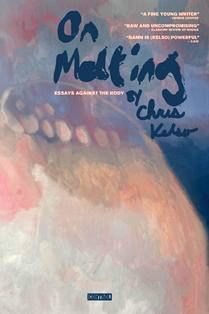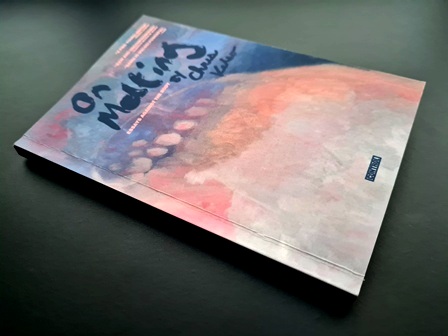
First published back in October of 2024, British author Chris Kelso’s ‘On Melting’ is a compilation of thought-provoking essays written by the author about that which is in opposition to the body.
Kelso sets out starting with the position of discussing Body Horror and our inherent discomfort at the idea of seeing the human body melting. Indeed, Kelso muses that there’s nothing that shocks us more, on a cellular level, than witnessing a body in full protoplasmic dissolve.
From this baseline position Kelso explores the lasting impact of Francis Bacon’s ‘Screaming Pope’ and Salvador Dalí’s ‘Soft Watches’ paintings. This fascination, perhaps even a morbid fascination, is followed by a dive into the more modern world of film, where we’re reminded of the character of Emil who’s flesh we see deteriorating after being doused in toxic waste within the iconic film ‘Robocop’ (1987).
After this, Kelso shifts his scope to covering the rare disorder of Stevens-Johnson Syndrome (SJS), in which we lean the top layer of one’s skin dies and moults. Despite the unpleasantness of this infliction, we’re subsequently reminded this of course, isn’t really a physical melting, and can almost be taken away from our ponderings on the matter.
Another short leap of subject-perspective takes us to the ‘Degeneration Theory’, which saw popularity in the late 19th century. With this we’re led to consider the notion that our civilised selves becoming susceptible to a kind of ‘primal relapse’, with our civilised exterior gradually melting away.
By now we’re gaining an understanding of the various tentacles of discussion which Kelso is willing to explore, a sizeable extension away from the core idea of physical human melting. However, reeling us back to this base idea again, Kelso then discusses the reception of films like ‘The Incredible Melting Man’ (1977) and ‘The Fly’ (1986). Here, Kelso considers how horror films often utilise ‘the melting man’ as reflecting the extreme consequences of corporate negligence, or of not that, then simple human folly, as he reels off the base plots for ‘The Stuff’ (1985), ‘Street Trash’ (1987), ‘Body Melt’ (1993), and the melt-orgy in ‘Society’ (1989).
Next, spontaneous human combustion has a brief mention, but again Kelso folds that its connection with the melting of flesh and bone is only vague at best. At this stage we take a sudden nosedive off a cliff edge, by extending the concept of melting to encapsulate metamorphosis and all things therein.
Gregor Samsa’s metamorphosis into a cockroach within Franz Kafka’s novella ‘The Metamorphosis’ (1915) takes the front seat of such discussions. Here we chew the fat on the idea of rebelling against society’s body and the author’s ingenious portrayal of this.
It’s not a huge leap of faith to move this willing metamorphosis into the physical disruption of flesh. The infusion of flesh and technology is the obvious choice for this next thread, with the likes of Cronenberg’s ‘Existenz’ (1999) held as a key token within this cultural discussion.
Retaining that core physical human relationship with the melting of oneself, Kelso then ponders why we’re so inherently distressed by the sight of our own insides. As he so eloquently puts “we are simply not meant to see the wizard behind the curtain”, before we’re encourage to take the next step over the divide between mind and flesh.
It’s however, not long before we’re back onto the union of the organic and technological, and indeed how this unification may very well get us closer to that spiritual transcendence we all subconsciously seek. In merging with other physical matter, we find things out about ourselves. It’s a thought-provoking idea, stripped bare and exposed for us to perhaps pause and consider.
And indeed, that’s very much what this melting pot of essays sets out to provide. A spiderweb of interconnected ideas and concepts, carefully coordinated into a journey of thought-provoking passages. The core concept of melting…
When ingested in one sitting (not a particularly audacious feat being a pocket-sized paperback), the book takes you on a journey that’s hard to put down. In fact, it’s almost akin to a mind-bending trip, through a quagmire of provocative ponderings and thinly tied-together concepts.
Of course, at the core we have the starting concept of human melting. But from this baseline position, Kelso explores more than just the physical idea, but instead using melting as a metaphor, a concept, almost a platform for your mind to jump off and roam the outer realms of physical and metaphysical metamorphosis.
Now, essentially what we have here is a collection of short essays linked together with the theme of melting…or precisely the opposition of the body. At times this is perhaps tantamount to a thoroughly unpretentious whispering philosophy. At others, an informed dissection of pop culture and the historical footprints which led us here.
All through this the essays are almost poetic in their delivery. The choice of words, the rhythm and the carefully considered coarse of this interconnected (but somehow still fragmented) journey which Kelso has plotted out for us.
The exploration of the piece probably reaches further afield than the opening pages, and perhaps your preconceived thoughts on the book contents, might have led you to think it would. From modern pop culture, to historical works, to literary pieces, and everything in between. But more than that it presents a unified creative philosophy which ties this whole spiderweb of ideas together into a collective whole.
Yes, at the start, at the core, is that physical conceptualised idea of the physical human form melting ala the bread-and-butter of Body Horror. But the areas covered, almost conversationally so, are far from just that visually discomforting starting place. This is an ocean’s length from merely gawping in delighted revulsion at ‘Meltin’ Milton’ or ‘Oozy Suzy’ Garbage Pail Kids cards. This is a purposefully open-ended internal discussion. A sandbox for ideas and concepts to be played around with.
At times the presentation of Kelso’s delivery feels like we’re in debate. It’s all words on a page, but the ponderings are so intently thought-provoking that we’re in some ways brought into the discussions. It’s that (undoubtedly deliberate) open-endedness which makes this happen. How the stepping stones we follow through the essays seem to be reactive to your mind’s own direction.
There are moments in the book which will probably have its readers tumbling down a rabbit’s hole of discovery. Kelso’s description of John Martin’s painting ‘The Deluge’ (1834) had me googling this immensely evocative piece (if you’re not familiar, then have a quick search now).
The discussions involving more recent artists such as Orlan, Stelarc and Ebecho Muslimova were an unexpected avenue to take. To that end, these aspects verged on a solidly condensed amalgamation of David Wood’s superb ‘Body Probe’ (1999), aspects of Chris Townsend’s ‘Vile Bodies’ (1998), and even the non-spiritual but more cultural and metaphysical conversations had within V. Vale and Andrea Juno’s ‘Modern Primitives’ (1989).
As in David Wood’s aforementioned book, Cronenberg’s films are here referenced and considered at multiple stages. Kelso’s exploration of what he calls “a co-evolution of flesh and metal establishing a new symbiosis – a mecha”, then takes the logical progression to Shinya Tsukamoto’s ‘Tetsuo: The Iron Man’ (1989), edging us into a perhaps bleaker (although not quite to the extent of feeling nihilistic) series of considerations around the subject. Kelso tackles this well, with a concise razor-sharp line cutting through this veritable quagmire of exploding avenues which could otherwise sidetrack the whole piece.
As a non-gamer, I have to admit I was a little hesitant with losing interest when Kelso moved the discussions onto the world of gaming, and more precisely, the video game ‘Silent Hill 2’ which YouTuber and architectural/video-gamer essayist, Jacob Gellar declares as “legitimate art” (and to be fair, succeeds in justifying this statement too!). Kelso then has an interview-style conversation with Gellar about this (apparently) ingeniously original video game. To be fair, this again, is actually incredibly interesting and made me even consider looking into what this game might entail purely out of intrigue.
Ultimately though, what we have with ‘On Melting’ is a journey through (quite frankly) a mind-boggling expanse of ideas and concepts, where we’re provoked to consider much, much more than the physical and the cultural. In fact, we discover an emotional attachment to the very concept of melting. At first repulsion, but then further layers behind this disruption of flesh which are less abhorrent. Like the heart-breaking ending to Raymond Briggs’ masterpiece ‘The Snowman’ (1982), Kelso makes us think far beyond mere matter, and instead ideas from existence and what’s beyond our gradually disentangling flesh. The twined paradox of physical and metaphysical.
Although after chewing the fat on the subject for so long, one question remained. Why no mention of ‘Troma’ movies?! Oh Chris, you probably coulda sneaked The Toxic Avenger in without any of the highbrow folk noticing!
The book runs for a total of 85 pages.

© DLS Reviews









